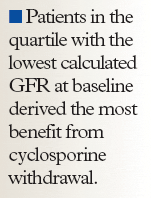- Safety & Recalls
- Regulatory Updates
- Drug Coverage
- COPD
- Cardiovascular
- Obstetrics-Gynecology & Women's Health
- Ophthalmology
- Clinical Pharmacology
- Pediatrics
- Urology
- Pharmacy
- Idiopathic Pulmonary Fibrosis
- Diabetes and Endocrinology
- Allergy, Immunology, and ENT
- Musculoskeletal/Rheumatology
- Respiratory
- Psychiatry and Behavioral Health
- Dermatology
- Oncology
Sirolimus maintenance regimen improves graft survival in kidney transplant recipients
Kidney transplant recipients on an immunosuppressive regimen of sirolimus plus cyclosporine who had their cyclosporine withdrawn at an early stage had significantly better graft survival than patients who remained on cyclosporine. The advantage appeared to be related to significantly improved kidney function in the patients in whom cyclosporine was withdrawn, reported Graeme Russ, MD, at the American Transplant Congress 2005 in Seattle, Wash.

The finding comes from 4-year data from the Rapamune Maintenance Regimen study, the largest cyclosporine withdrawal study to date. In the study, 430 of 525 enrolled patients were eligible to be randomized to remain on cyclosporine, sirolimus, and steroids or to have the cyclosporine withdrawn at 3 months, remaining on a maintenance regimen of sirolimus and steroids.
At 4 years, the rates of biopsy-proven acute rejection were not significantly different between the 2 groups-15.8% in patients maintained on cyclosporine and 20.5% in patients in whom cyclosporine had been withdrawn (P=.260).

Outcomes were then assessed according to renal function at the time of conversion (3 months). Patients were divided into quartiles based on calculated glomerular filtration rate (GFR): <45 mL/min, 45 to 56 mL/min, >56 to 67 mL/min, and >67 mL/min.
"In all groups, kidney function was better at 4 years with withdrawal of cyclosporine," said Dr Russ, professor and director of nephrology and transplantation services, The Queen Elizabeth Hospital, Woodville, South Australia. "GFR improved and continued to improve over 48 months with cyclosporine withdrawal but stayed the same or dropped with continued cyclosporine," he said.
Overall, mean GFR was 58.3 mL/min in patients who had cyclosporine withdrawn compared with 43.8 mL/min in those maintained on cyclosporine (P<.001).
Mortality increased with declining renal function in either treatment group.
Patients in the quartile with the lowest calculated GFR at baseline derived the most benefit from cyclosporine withdrawal, according to Dr Russ. In this quartile, the difference in graft survival was statistically significant in favor of the sirolimus maintenance regimen compared with the continued cyclosporine regimen. No significant difference in graft survival emerged between the treatment groups in patients with renal function in the highest 3 quartiles.
The side effect profile was similar between treatment groups in all 4 quartiles.
"Early, progressive, and complete withdrawal of cyclosporine from a combination of sirolimus, cyclosporine, and steroids is preferable to continuing on this regimen, irrespective of baseline renal function," said Dr Russ. "The difference was most marked in patients with baseline calculated GFR <45 mL/min."
There is no current consensus on the optimal timing of cyclosporine withdrawal in kidney transplant recipients, said Myron Kauffman, MD, senior research scientist at the United Network for Organ Sharing (UNOS). "In general, the aim is to start withdrawing before damage occurs but we don't know when exactly that is right now," he said. "UNOS databases will provide the numbers to make this determination."
Coalition promotes important acetaminophen dosing reminders
November 18th 2014It may come as a surprise that each year Americans catch approximately 1 billion colds, and the Centers for Disease Control and Prevention estimates that as many as 20% get the flu. This cold and flu season, 7 in 10 patients will reach for an over-the-counter (OTC) medicine to treat their coughs, stuffy noses, and sniffles. It’s an important time of the year to remind patients to double check their medicine labels so they don’t double up on medicines containing acetaminophen.
Support consumer access to specialty medications through value-based insurance design
June 30th 2014The driving force behind consumer cost-sharing provisions for specialty medications is the acquisition cost and not clinical value. This appears to be true for almost all public and private health plans, says a new report from researchers at the University of Michigan Center for Value-Based Insurance Design (V-BID Center) and the National Pharmaceutical Council (NPC).
